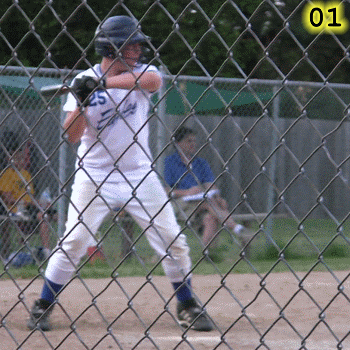What Does NOT Work
When my older son started to struggle with Bat Drag, I looked at every video on the Internet, read every article, and tried every solution that I could find.
What I found is that NONE of the proposed solutions for Bat Drag don't work.
I know, because I tried them all.
Heavy Bat
When I realized my older son had a problem with Bat Drag, the first thing I did was but him a heavier, wood bat.
I was assured that would quickly improve in swing. Instead, it made it (much) worse, not better.
What I saw on video was what you see in these two frames of a hitter using the Sledge Bat, which is a type of heavy bat that is targeted at kids.
In the picture above, notice how the hitter's front arm is fully extended and barred out and his back elbow has slid forward of his back hip.
In the picture above, notice how the hitter is in the standard stacked elbow position, with the back elbow just below the front elbow.
At the end of the day, heavy bats don't work because Bat Drag isn't just a problem of strength. Instead, Bat Drag is a problem with where and how the hitter generates force. Until you address that problem, a heavy bat is likely only going to make Bat Drag worse and not better.
In my experience, solutions like the use of a heavy bat to deal with Bat Drag do not work. Instead, they tend to make a problem with Bat Drag worse. In fact, I would argue that the reason why both of my boys had fairly serious problems with Bat Drag wasn't that I didn't have them swing with heavy enough bats.
Instead, the problem was that I gave them heavy bats too soon.
As a result, I am fairly cautious when it comes to heavy bats and slow to adopt them, at least when it comes to kids who aren't yet in 7th or 8th grade.
Bat on the Side of the Shoulder
The main thing I tried when working on my older son's Bat Drag was having him do a number of drills in which you put the bat on the side of your shoulder and swing from there, much as you see demonstrated in videos like these...
While he showed some slight improvement when doing this, when I looked
at his swings on video I saw that his Bat Drag was just
being masked, not
eliminated.

Bat on the Side of the Shoulder and Bat Drag
What's worse, and as was the case for the hitter above, merely putting the bat on the side of his back shoulder and dropping his back elbow to his side, in the absence of any other instruction, seemed to increase the temptation for him to start the swing by pulling with his back elbow.
In my (direct) experience, putting the bat on the side of the shoulder only works if you accompany it with a complete set of instruction and cues as I do with the George Brett Drill and, just as importantly, know what "gotcha's" to look for.
Getting the Back Elbow Up
When my son and his teammates were younger, one cue that did seem to work was telling them to get their back elbow up. While I don't have video to prove it, I believe that getting the back elbow up made it less likely that they would be late in starting their swing and more likely to be on time. Basically, it made them more direct to the ball (and direct to the ball is a good thing in most young hitters). However, that cue stopped working in 3rd grade when we moved to kid pitch and hitting wasn't as simple as timing the pitch as it came out of the pitching machine.
Turning the Barrel
Some people swear that teaching hitters to turn the barrel will fix Bat Drag. However, in the case of my older son, his problem was that he already turned the barrel too much with his hands. As a result, telling him to turn the barrel turned a long, slow, sweep-y swing into an even longer, slower, sweep-ier swing. At the core, he wasn't doing the right things with his hands and wrists and and telling him to turn the barrel, as it is commonly taught, made things worse and not better.
There are many videos and articles out there that purport to fix bat drag. However, I tried most of them out when working with my older son and found that they either don't work or they work for reasons that are different than are proposed. It was their minimal to total ineffectiveness that led me to research Bat Drag and to come up with my own solutions to it.